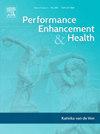Social network exposure and sociodemographic factors associated with intentions to use anabolic-androgenic steroids
IF 3.7
Q2 HOSPITALITY, LEISURE, SPORT & TOURISM
引用次数: 0
Abstract
Objectives
This study aimed to examine 1) perceived anabolic-androgenic steroid (AAS) use within the social networks of non-consumers, 2) the intentions to use AAS among non-consumers, including the sociodemographic predictors of intentions to use, and 3) whether perceived AAS use within one’s social network is associated with intentions to use.
Methods
Data from 1515 boys and men from Canada and the United States were analyzed. Descriptive statistics were used to describe perceived AAS use within the social networks of participants and their intentions to use AAS. Linear regression analyses were used to determine the sociodemographic associations with intentions to use AAS and whether perceived AAS use within one’s social network is associated with AAS use intentions.
Results
Over one third (34.9 %) of participants reported perceiving any individual in their social network who uses AAS, while intentions to use AAS were relatively weak. Participants who identified as multi-racial were associated with stronger intentions to use AAS, while those who identified as gay or had a master’s degree or higher were associated with weaker intentions to use. Participants who perceived anyone in their social network who used AAS were associated with stronger intentions to use themselves.
Conclusion
These findings provide novel insights into AAS use within the social networks of a large, diverse, and international sample of boys and men, and their intentions to use. Prevention efforts should focus on boys and men who identify as multi-racial and who have individuals in their social network who use AAS.
社会网络暴露和社会人口因素与使用合成代谢雄激素类固醇的意向有关
本研究旨在研究1)非消费者社交网络中合成代谢雄激素类固醇(AAS)的使用情况,2)非消费者使用AAS的意图,包括使用意图的社会人口预测因素,以及3)社交网络中AAS的使用是否与使用意图相关。方法对来自加拿大和美国的1515名男孩和男性的数据进行分析。描述性统计用于描述参与者在社会网络中感知到的AAS使用情况以及他们使用AAS的意图。使用线性回归分析来确定社会人口学与AAS使用意图的关联,以及在一个人的社会网络中感知到的AAS使用是否与AAS使用意图相关。结果超过三分之一(34.9%)的参与者报告认为他们的社交网络中有任何个人使用AAS,而使用AAS的意愿相对较弱。被认为是多种族的参与者使用AAS的意愿更强,而那些被认为是同性恋或拥有硕士学位或更高学历的参与者使用AAS的意愿更弱。那些认为自己的社交网络中有人在使用AAS的参与者更倾向于使用自己。这些发现提供了关于AAS在一个大的、多样化的、国际性的男孩和男人的社会网络中的使用情况,以及他们使用AAS的意图的新见解。预防工作应侧重于那些被认为是多种族的男孩和男性,以及他们的社交网络中有人使用AAS。
本文章由计算机程序翻译,如有差异,请以英文原文为准。
求助全文
约1分钟内获得全文
求助全文
来源期刊

Performance enhancement and health
Social Sciences-Health (social science)
CiteScore
4.70
自引率
0.00%
发文量
27
审稿时长
57 days
 求助内容:
求助内容: 应助结果提醒方式:
应助结果提醒方式:


